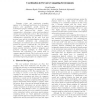Free Online Productivity Tools
i2Speak
i2Symbol
i2OCR
iTex2Img
iWeb2Print
iWeb2Shot
i2Type
iPdf2Split
iPdf2Merge
i2Bopomofo
i2Arabic
i2Style
i2Image
i2PDF
iLatex2Rtf
Sci2ools
WETICE
2003
IEEE
2003
IEEE
Coordination in Pervasive Computing Environments
Computer science and engineering nowadays appears to be challenged (and driven) by technological progress and quantitative growth. Among the technological progress challenges are advances in submicron and system-on-a-chip designs, novel communication technologies, micro-electro-mechanical systems, nano and materials sciences. The vast pervasion of global networks, the growing availability of wireless communication technologies for the wide, local and personal area, and the evolving ubiquitous use of mobile and embedded information and communication technologies are indicators for accelerated quantitative growth. We perceive a shift from the “one person with one computer” paradigm, which is based on explicit human machine interaction, towards a ubiquitous and pervasive computing paradigm, in which implicit interaction and cooperation is the primary mode of computer supported activity. This, however, poses serious challenges to the conceptual architectures of computing, and related ...
Communication Technologies | Emerging Technology | Quantitative Growth | Technological Progress | WETICE 2003 |
| Added | 05 Jul 2010 |
| Updated | 05 Jul 2010 |
| Type | Conference |
| Year | 2003 |
| Where | WETICE |
| Authors | Alois Ferscha |
Comments (0)

